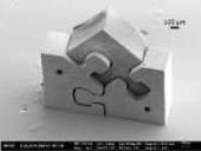The world's smallest puzzle
|
|
|
Three-piece puzzle, assembled from plastic micro-components, produced by the "LIGA2.X" process |
New "LIGA2.X" process produces high-precision plastic micro-components / Research with the large-scale ANKA facility enables industrially applicable injection molding application
Three puzzle pieces, each almost a millimetre in size, fit together to form probably the smallest puzzle in the world. Scientists have produced it using the new „LIGA2.X" process, which creates microstructured casting molds with the ANKA synchrotron radiation source at KIT. This enables cost-effective mass production and maximum precision on the microscale to be combined, for example for components in watches, motors or medical devices. Tiny injection molded parts in large quantities with highest precision are now possible.
The LIGA process can be used to produce microstructures from various metals, ceramics or synthetic materials. The acronym means lithography, electroplating and impression. LIGA enables structures with high aspect ratios (height relative to the smallest width) and gives many possibilities for shaping. The process developed in Karlsruhe in the 1980s is constantly being refined. KIT scientists have now developed a new modification of the LIGA process.
The LIGA2.X process is aimed at the cost-effective mass production of plastic micro-components with a volume of less than 0.5 cubic millimeters. Micro injection molding of parts of this size used to require a substrate plate to connect the components together so that they could be removed from the mold. LIGA2.X makes this layer superfluous and allows the components to be manufactured directly and individually via micro injection molding. This eliminates the difficult, time-consuming and costly separation of the components from the substrate plate. "LIGA2.X not only saves costs but also allows greater freedom in the arrangement of structured mold cavities in multiple molds," Jochen Heneka, research associate at the Institute for Microstructure Technology (IMT) and the Institute for Applied Materials - Materials Science (IAM-WK) of KIT, explains.
The micro injection molding tools used in LIGA2.X consist of three plates to release the individual molded parts out of the mold, and four LIGA molds, which can be interchangeably installed in a mold plate. The component is released from the LIGA mold by moving the first and second mold plate apart, and the sprue is cleanly removed with the aid of the third plate. The scientists used the ANKA synchrotron radiation source on Campus North of the KIT to produce the microstructured LIGA shapes using deep X-ray lithography.
The Karlsruhe Institute of Technology (KIT) is a public corporation according to the laws of the state of Baden-Württemberg. This takes on both the mission of a university and the mission of a national research centre in the Helmholtz Association. The thematic priorities of research include energy, the natural and built environment and society and technology, ranging from fundamental questions to applications. With around 9000 employees, including almost 6000 in science and teaching, and 24 000 students, the KIT is one of the largest scientific and academic institutions in Europe. KIT is pursuing its tasks in the science triangle of research, teaching, and innovation.
This Press Release is available on the Internet at: www.kit.edu
The image is available for download at www.kit.edu and can be requested at: presse∂kit.edu oder +49 721 608-47414. edu or +49 721 608-47414. The use of the image is only permitted in the above mentioned context.

